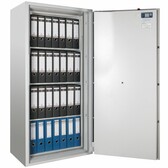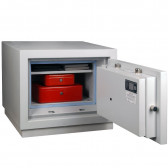Safes have been an integral part of reality for many centuries when we think about securing diverse values. Once significantly different in appearance from today's safes and used only by the most affluent. Nowadays, one could say that safes have gone "under the radar" (to use such a phrase lightly, of course).
Safes are designed for storing valuables and it is no longer just money and valuables, as it once was. Now, people deposit what is important to them and what they perceive as things of value in a safe. In the past: gold, ducats, all sorts of valuables. Nowadays: things that seem quite 'normal': apart from cash, which is probably the first thing that comes to mind when you think of a 'safe', also documents (not that trivial, as important contracts, deeds, policies, wills, passports), jewellery, watches, precious metals (after all, you have to invest in something when money loses its value), but also priceless personal objects and keepsakes.
Safes are not only a practical solution for protecting valuable items, documents or money. While they were once a symbol of luxury, today they symbolise responsibility and the desire to provide your values with a secure place to hide them.
We will explore the ins and outs of safes in this article – you will be introduced to key information, learn about the different types of safes and what to look out for if you are just facing the decision to buy one.
Safes – the place of installation
Customers often ask us the question "Where is the best place to install a safe?". This depends on many factors and the type of safe. However, it is best to mount the safe in a location which is:
• dry: so we exclude places where the safe may be exposed to water and moisture;
• accessible: this means that the safe must be easy to access and comfortable to use (e.g. if a low safe is mounted on the floor, you will have to bend down a lot to reach the items stored in it);
• with sufficient space: it is worth bearing in mind that most safes have external hinges, components that stand off from the top of the door (handle, lock keypad) and the ability to open the door more than 90°. If you have an alcove prepared for a safe, for example, it is worth bearing these elements in mind;
• non-obvious and invisible at first glance: make it difficult for a potential thief – don't let the safe be the first thing he sees when he enters the place he wants to rob. The safe can be placed in a built-in piece of furniture (it can also be a wardrobe or a desk) and should necessarily be anchored to the wall or the floor.
Types of safes for storing valuables – their purpose
At HARTMANN TRESORE, we have a wide range of products that have different purposes. It is worth emphasising that within this division, safes with different security classes are available to choose from. Our range includes:
• furniture safes – safes that are generally lightweight and designed to store small values, ideal for mounting even on a furniture shelf. These are small, compact models, in basic security classes and giving basic security. This category often includes the sub-category known as "home safes", although if you intend to store valuable items in a safe – we recommend burglar safes, which have higher security classes.
• burglar-proof safes – certified, heavy, difficult to move and difficult to break into. The greater is the value of the items that will be deposited in the safe to you, the higher should be its security class.
• fireproof safes and document cash-boxes – these are burglar-proof safes which are also certified for fire resistance. For the period of time indicated in the certificate (30, 60 or 120 minutes), paper documents are protected in such a safe and resistant to fire, heat and flooding (in the event of fire, the seals fitted around the door swell and seal the door tightly). Document safes are the ideal protection for paper documents.
• safes for data carriers – data carriers are much more sensitive to heat, so we have a separate category of safes for them.
• wall safes and floor safes – walled models. Some of the most 'discreet' safes, as it takes longer to find them, let alone rip them out of the wall or floor.
• key safes – ideal for the orderly storage of multiple keys. They are ordered by offices, businesses, institutions and are useful wherever keys – whether door keys or car keys – need to be secured.
• drop safes and deposit safes – trade=rotation. Drop safes are characterised by the fact that any employee can deposit envelopes of money (via the drop box), but only a select few know the code to the main door.
• vault doors and vaults – "heavy duty" products, often with higher burglary resistance classes.
• exclusive safes – we will design and manufacture a safe according to your specifications. Are you dreaming of a high-gloss or matt lacquered safe? Do you need to protect your watches or jewellery collection in a safe? Do you want the safe to be visually stunning (in addition to its practical dimension)? We will make your dream model for you.

Classes of safes
Does the phrase "burglar-proof" mean that an unauthorised person or burglar will never get into a certified safe? In an ideal world, this would probably be the case. In reality, any safe or even a vault can be hacked, two words are key: time and tools. The lower the class of the safe, the faster it can be accessed (partially and completely).
The classes of safes and cash-boxes are designated as follows:
• S1: basic security, the construction of the safe is simple – one sheet of metal 3 mm thick. The door is double-walled.
• S2: the body consists of two 3 mm thick metal sheets, no filling in the middle. The door is also double-walled.
• 0-V: the higher the security class of the safe, the more sheet metal coats with different types of filling in between.
Safe locks
'How many locks should a safe have?' and 'which type of lock should I choose?' are the 2 basic questions customers ask before making their choice. In security classes S1-III, a single lock is sufficient. From security class IV and upwards, safes must be equipped (according to the certificate) with a combination of two locks. So which locks can be used in safes?
• key locks – they are the basic and standard equipment of a safe. The lowest price for a safe includes just the key lock. All other locks are optional. Is the key lock a good lock? It is a class lock, while customers sometimes perceive it as a kind of 'hindrance': the key is at least a few centimetres long and there are 2 pieces in the set. Care must be taken to ensure that these physical keys are well secured so that they do not fall into the unauthorized hands. Key locks are virtually fail-safe (unless the key is broken).
• cipher – these are the silent heroes of American movie scenes, because if a safe appears in them, it's strangely a knob safe. Faultless and the most environmentally friendly type of lock, because it is not powered by batteries nor does it need mains power. To open the safe, you need to unscrew the cipher using the dial.
• electronic locks – to open the safe you just need to enter a combination of digits on the keypad. These are battery-powered locks (if they are discharged, the code is memorised and we have the option of connecting a battery externally to open the lock and replacing the battery with a new one).
• biometric – we use biometric locks with a fingerprint reader and thermal reading method in Hartmann Tresore products.
In our blog, or Knowledge section, you will find a number of articles about safe locks, including: Which lock to choose for safes?
Key functions of safes
A safe can cost several, tens or even hundreds of thousands of zlotys. However, it is worth looking at its purchase as an investment rather than an unnecessary expense. This investment will protect your valuables from unauthorised access and theft. What do you gain by investing in a safe?
• security first: the primary function of a safe is, of course, to provide physical security for the valuables stored in it. Durable materials and robust construction make them resistant to attempted break-ins or physical damage;
• protection against external factors: fireproof safes provide protection against various external threats such as fire or flooding from fire extinguishing agents;
• peace of mind: even when the safe is left alone at home, your valuables are secure inside and you have peace of mind.
Summary
In today's world, where security is one of the priorities, safes play an important role. They are not only used in houses, but also in offices, businesses, banks, hotels or public institutions. They ensure peace of mind by protecting values and documents from loss or theft. Don't just buy any first-best safe. This investment requires thought, comparing different classes of security.
At HARTMANN TRESORE, we are in the business of providing advice to ensure that each customer gets the best possible product, suitable for their needs but also for their budget. So: if you are looking for a safe, a cabinet or an armoured strongbox to store important documents, cash, your other values – come to us.






